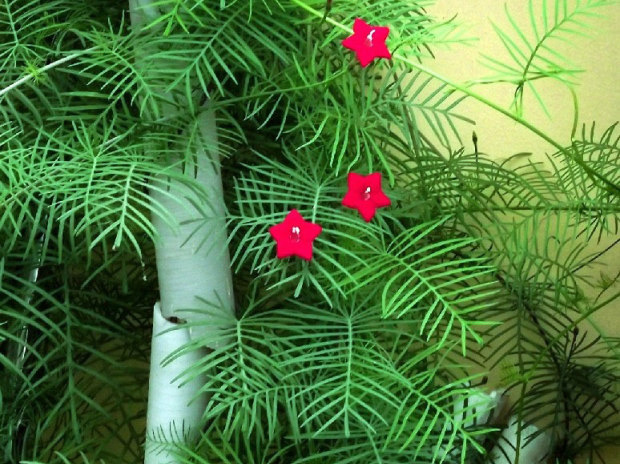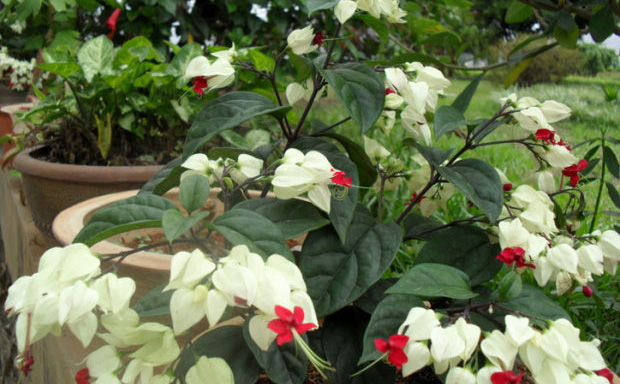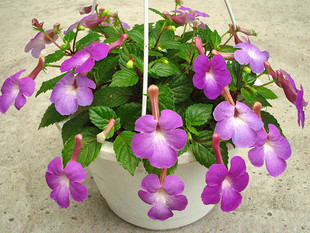Culture and cultivation methods of feather-leaf pineapple
The slender and tender vine long stem of the pinnacle is about 3m tall and is covered with slender pinnate linear lobed leaves. One or more flowers gather on the peduncle and are drawn from the axils of the leaves. The magenta high-footed dish-shaped flowers are like tassel on a green tapestry, and there are white, pink and red-and-white star-shaped flowers in cultivation. The florescence is from July to September. Artemisia angustifolia is an annual herbaceous vine of Convolvulaceae, which is native to tropical America. A terrain that enjoys sunshine and good drainage; it is not strict with soil, but grows better in fertile humus soil. Seeds for reproduction are sown directly or in pots in March and April in the warm and sunny part of the courtyard. Because of its strong taproot, it is suitable for direct seeding or pot planting; for pot sowing, it should be transplanted as early as possible; keep the sowing soil moist after sowing, and sprout after about a week. When the seedling height is 10 cm, the seedling can be fixed, and the row spacing of the plant planted in the courtyard is about 20 cm.

Feather-leaf pineapple should be planted under the courtyard bamboo fence or windowsill, as well as open-field flower paths, low walls and scaffolding; residential buildings can also be planted in shallow pots on windowsills or balconies. The mixed soil of fertile rotten leaf soil and garden soil is better for potted soil. Generally, 3 plants of 2Mel can be planted in flowerpots with a diameter of about 15 centimeters. After planting, they are drawn with string in time with the growth of seedlings, so that the trailing stems are wound up, and fine bamboo slices can be used to form various kinds of flowerstand bonsai. When the seedling height is 50 cm, it is necessary to increase topdressing and watering, then the vine stem growth is accelerated, the branches and leaves are luxuriant, the flowering is many and the color is bright. If it can be planted in a warm place in March, it can be planted in advance, so that the florescence can be advanced by more than a month. When the seeds mature from August to October, we should pay attention to the timely harvest and prepare the culture methods for sowing and feathering pineapple in the second year.
Feather-leaf pineapple, also known as pineapple, dragon grass, Jinpingfeng, dragon flower, etc., is an annual twining herb of the genus Prunus, native to tropical America, and is now widely distributed in the global temperate zone and tropics. It is relatively simple to cultivate and is a beautiful garden ornamental plant. Let's take a look at the breeding methods of Prunus chinensis.
The growth habit of Euphorbia pinnata
The feather leaf pineapple likes light, likes warm and humid environment, grows in the area of 0 to 2500 meters above sea level, is not cold-resistant, can self-sow (generally introduced by artificial cultivation), requires fertile soil. Strong resistance and easy management. The seedlings were planted artificially in March and the seedlings were transplanted with a length of 10 cm. In order to bloom more, it should be planted in the fertile soil in the sunny place. Potted plants should stand on brackets for winding, and they are extremely slender and beautiful when they bloom.
The Propagation method of Euphorbia pinnata
Feather-leaf pineapple is usually sown and propagated with seedling tray, about 100 grams per square meter of seedling bed, and about 1.5 cm of fine soil is covered after sowing, which is not too thin, otherwise it is easy to unearthed with seed coat. When the soil temperature is controlled at 20-25 ℃, the seedlings will emerge 4 days after sowing, but the seedlings are often irregular, so the seedlings should be carefully selected in order to make the seedlings neat. Seedlings are very afraid of drought, when the drought is slightly severe, it will die, even watering is difficult to recover, seedlings should pay special attention to this.
The culture method of feather-leaf pineapple
1. Selection of pots: choose a flowerpot of appropriate size, and the bottom hole of the pot is covered with two tiles or thin foam sheets, not only to ensure that the soil is not washed out by water, but also to allow excess water to flow out in time. A layer of ceramsite or broken red brick is placed on the tile or foam to serve as a filter layer, about 2cm to 3cm thick.
2. On the basin: when the small seedlings of the feathered pineapple are installed in the basin or the large plants that have been raised for several years are turned into the basin, put a coarse-grained matrix 2cm thick as a filter layer at the bottom of the basin, sprinkle a layer of fully mature organic fertilizer as the base fertilizer, with a thickness of about 1cm and 2cm, and then cover it with a thin layer of matrix, about 1cm thick, and then put in the plant to separate the fertilizer from the root system to avoid root burning.
3. Fertilizer and water: the feather-leaf pineapple is watered once after it is finished in the basin and maintained in a shaded environment for a week. When transplanting the seedlings, first dig the planting hole, sprinkle a layer of organic fertilizer at the bottom of the planting hole as the base fertilizer (base fertilizer), with a thickness of about 4cm to 6cm, and then cover a layer of soil and put it into the seedlings to separate the fertilizer from the roots and avoid burning roots. After putting it into the seedling, backfill the soil, cover the root system, and trample the soil with your feet and water it once.
4. Pruning: when the plant enters dormancy or semi-dormancy period in winter, the branches such as thinness, disease and insect, withered and overdense should be cut off. The branches can also be arranged in combination with cuttings.
5. Take off the basin: put the flowers that want to change the pot on the ground, first pat the four sides of the basin with a slap, so that the root system is shaken and separated from the basin wall, put the flowerpot upside down on the left hand, gently clamp the plant with the index finger and middle finger of the left hand, hold the edge of the basin with the wrist and fingertip, hit the bottom of the basin with the right hand, and then use the mother finger to top the root soil down from the bottom hole to let the plant out. After taking it off, gently pat the basin soil with both palms to let the excess soil fall off.
6. Change the basin: the maintenance method of the feather pineapple will grow very fast. when it grows to a certain size, we should consider changing it to a larger basin so that it can continue to grow vigorously. The culture soil and component ratio for basin change can choose one of the following, vegetable garden soil: slag = 3:1, or garden soil: medium coarse river sand: sawdust (slag) = 4:1:2, or one of paddy soil, pond mud, rotten leaf soil.
The cultivation of Euphorbia pinnatifida, also known as pineapple, is an annual trailing herb of the family Convolvulaceae and Artemisia. The stem is up to 4 meters long, smooth, weak, simple leaves alternate, leaves pinnately lobed, lobes linear and neat, stipules and leaves of the same shape. The green feathered leaves are like feathers, whirling lovely, and red flowers are dotted with stars.
Pineapple is native to America, likes light, likes warm and humid environment, is not tolerant to drought, does not choose soil, has strong adaptability and extensive management. Pineapple breeding seeds, picking seeds should use the first and second batch of flowers to produce fruit, full and good quality. In late spring and early summer, use seed hole sowing (or pot sowing), sowing 3 to 5 seeds in each hole, keep the sowing soil moist, germinate after about a week, and can be planted when the seedling is 10 cm high. Pineapple should be planted under the courtyard bamboo fence or windowsill, and the flower path in the open field. For example, when potted, the pot soil should be mixed with fertile rotten leaf soil and garden soil. The seedling stage is weak, the underground part is straight root, the whisker root is few, and it is not tolerant to transplant. If you want to transplant, take advantage of the small seedlings with more soil, or in cloudy days, in order to improve the survival rate. During the growing period, frequently watering and topdressing, picking the heart for 2 to 3 times after striping to promote branching, and set up a frame to guide the vine to grow and blossom.
- Prev

Cultivation and culture methods of dragon spitting beads
Longtuzhu is native to tropical Africa. Now widely cultivated in various parts of our country, it is a very beautiful indoor potted flower. The flower is born at the top of the branch, the calyx is white, and when it blossoms in summer and autumn, the crimson Corolla protrudes from the white calyx, shaped like a swimming dragon spitting beads, hence the name of the dragon spitting beads.
- Next

Matters needing attention in culturing long tube flowers (sleeve)
Achimenes, also known as sleeve flower and juggling grass, is deeply loved by European and American people like her close relatives, big rock tree and African oyster, and is often regarded as the protagonist of summer ground cover plant or hanging basin plant. Her popularity can be confirmed by having many English common names.
Related
- Fuxing push coffee new agricultural production and marketing class: lack of small-scale processing plants
- Jujube rice field leisure farm deep ploughing Yilan for five years to create a space for organic food and play
- Nongyu Farm-A trial of organic papaya for brave women with advanced technology
- Four points for attention in the prevention and control of diseases and insect pests of edible fungi
- How to add nutrient solution to Edible Fungi
- Is there any good way to control edible fungus mites?
- Open Inoculation Technology of Edible Fungi
- Is there any clever way to use fertilizer for edible fungus in winter?
- What agents are used to kill the pathogens of edible fungi in the mushroom shed?
- Rapid drying of Edible Fungi

